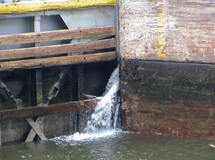 |
 |
|
| eNews • February 2012 | ||
| Promoting a Cost-Effective, Reliable and Competitive Transportation System |
||
 Crumbling Locks and Dams Endanger Farmer Profitability
Crumbling Locks and Dams Endanger Farmer Profitability
The deteriorating condition of the U.S. lock and dam system puts the competiveness of U.S. soybean farmers at risk according to a soybean checkoff-funded study. The study, “America’s Locks & Dams: A Ticking Time Bomb for Agriculture,” highlights how farmers “…will suffer severe economic distress” if catastrophic U.S. lock and dam failures take place.
“Over the past few years, one of the silver linings in our overall cloudy economy has been our agricultural sector,” explains Mike Steenhoek, executive director of the Soy Transportation Coalition. “U.S. farmers are efficiently producing the soybeans and other commodities in high demand around the world. However, our ability to maintain this momentum depends on a dilapidated inland waterways infrastructure. If our nation’s locks and dams are unable to connect our growing production with our growing demand, farmer profitability will suffer.”
More than half of the lock and dam structures that are part of the U.S. Inland Marine Transportation System exceed their 50-year usable lifespan, according to the report. More than one-third surpass 70 years of age, a concern because usually major rehabilitation is necessary to expand the typical lifespan from 50 to 75
Just on the Ohio River alone, the time locks have been out of service has more than tripled since 2000, rising from 25,000 hours to 80,000 annually. And that gets expensive. The study shows that a three-month lock closure would increase the cost of transporting 5.5 million tons of oilseeds and grain, the average amount of grain shipped by barge during that period, by $71.6 million. A failure at any of the locks examined by the study could cost U.S. farmers up to $45 million in lost revenue.
The U.S. inland waterways represent an important step in transporting U.S. soybeans. Up to 89 percent of soybeans exported through the lower Mississippi ports, such as the Port of New Orleans, arrive at those ports via the locks of the U.S. inland waterways.
The study was developed by the Soy Transportation Coalition and funded by the United Soybean Board’s Global Opportunities Committee. The Texas Transportation Institute at Texas A&M University was selected to perform the analysis – focusing on the condition of locks and dams on the Upper Mississippi River, Illinois River and Ohio River.
The study can be accessed at www.soytransportation.org or on the United Soybean Board’s website (www.unitedsoybean.org).
Soy Transportation Coalition |
|
